Climate Change for Lakes in the Coterminous United States in Relation to Lake Warming from 1981 to 2023
Abstract
1. Introduction
2. Materials and Methods
2.1. Lake Sample
2.2. Meteorological Data
2.3. Analyses of Meteorological Variables
2.4. Calculation of Near-Surface Water Temperatures
2.5. Rates of Change in Variables in Individual Lakes
3. Results
3.1. Changes in Mean Air Temperatures
3.2. Changes in Minimum Air Temperatures
3.3. Changes in Maximum Air Temperatures
3.4. Changes in Dew Point Temperatures
3.5. Changes in Precipitation
3.6. Water Temperature Model
3.7. Changes in Water Temperatures
4. Discussion
5. Conclusions
Funding
Data Availability Statement
Acknowledgments
Conflicts of Interest
References
- Edinger, J.E.; Duttweiler, D.W.; Geyer, J.C. The response of water temperatures to meteorological conditions. Water Resour. Res. 1968, 4, 1137–1143. [Google Scholar] [CrossRef]
- Zhou, J.; Leavitt, P.R.; Rose, K.C.; Wang, X.; Zhang, Y.; Shi, K.; Qin, B. Controls of thermal response of temperate lakes to atmospheric warming. Nat. Commun. 2023, 14, 6503. [Google Scholar] [CrossRef] [PubMed]
- Tong, Y.; Feng, L.; Wang, X.; Pi, X.; Xu, W.; Woolway, R.I. Global lakes are warming slower than surface air temperature due to accelerated evaporation. Nat. Water 2023, 1, 929–940. [Google Scholar] [CrossRef]
- Fink, G.; Schmid, M.; Wahl, B.; Wolf, T.; Wüest, A. Heat flux modifications related to climate-induced warming of large European lakes. Water Resour. Res. 2014, 50, 2072–2085. [Google Scholar] [CrossRef]
- Wang, S.; He, Y.; Hu, S.; Ji, F.; Wang, B.; Guan, X.; Piccolroaz, S. Enhanced warming in global dryland lakes and its drivers. Remote Sens. 2021, 14, 86. [Google Scholar] [CrossRef]
- Lathrop, R.C.; Kasprzak, P.; Tarvainen, M.; Ventelä, A.M.; Keskinen, T.; Koschel, R.; Robertson, D.M. Seasonal epilimnetic temperature patterns and trends in a suite of lakes from Wisconsin (USA), Germany, and Finland. Inland Waters 2019, 9, 471–488. [Google Scholar] [CrossRef]
- Sharma, S.; Gray, D.K.; Read, J.S.; O’reilly, C.M.; Schneider, P.; Qudrat, A.; Gries, C.; Stefanoff, S.; Hampton, S.E.; Hook, S.; et al. A global database of lake surface temperatures collected by in situ and satellite methods from 1985–2009. Sci. Data 2015, 2, 1–19. [Google Scholar] [CrossRef] [PubMed]
- Wang, X.; Shi, K.; Zhang, Y.; Qin, B.; Zhang, Y.; Wang, W.; Woolway, R.I.; Piao, S.; Jeppesen, E. Climate change drives rapid warming and increasing heatwaves of lakes. Sci. Bull. 2023, 68, 1574–1584. [Google Scholar] [CrossRef] [PubMed]
- Wang, W.; Shi, K.; Wang, X.; Zhang, Y.; Qin, B.; Zhang, Y.; Woolway, R.I. The impact of extreme heat on lake warming in China. Nat. Commun. 2024, 15, 70. [Google Scholar] [CrossRef] [PubMed]
- Wu, Y.; Ji, F.; Wang, S.; He, Y.; Hu, S. Increased Warming Efficiencies of Lake Heatwaves Enhance Dryland Lake Warming over China. Remote Sens. 2024, 16, 588. [Google Scholar] [CrossRef]
- O'Reilly, C.M.; Sharma, S.; Gray, D.K.; Hampton, S.E.; Read, J.S.; Rowley, R.J.; Schneider, P.; Lenters, J.D.; McIntyre, P.B.; Kraemer, B.M.; et al. Rapid and highly variable warming of lake surface waters around the globe. Geophys. Res. Lett. 2015, 42, 10–773. [Google Scholar] [CrossRef]
- Pareeth, S.; Salmaso, N.; Adrian, R.; Neteler, M. Homogenised daily lake surface water temperature data generated from multiple satellite sensors: A long-term case study of a large sub-Alpine lake. Sci. Rep. 2016, 6, 31251. [Google Scholar] [CrossRef] [PubMed]
- Winslow, L.A.; Hansen, G.J.; Read, J.S.; Notaro, M. Large-scale modeled contemporary and future water temperature estimates for 10774 Midwestern US Lakes. Sci. Data 2017, 4, 1–11. [Google Scholar] [CrossRef] [PubMed]
- Bachmann, R.W.; Canfield, D.E., Jr.; Sharma, S.; Lecours, V. Warming of near-surface summer water temperatures in lakes of the conterminous United States. Water 2020, 12, 3381. [Google Scholar] [CrossRef]
- Piccolroaz, S.; Healey, N.C.; Lenters, J.D.; Schladow, S.G.; Hook, S.J.; Sahoo, G.B.; Toffolon, M. On the predictability of lake surface temperature using air temperature in a changing climate: A case study for Lake Tahoe (USA). Limnol. Oceanog. 2018, 63, 243–261. [Google Scholar] [CrossRef]
- Zhu, S.; Ptak, M.; Sojka, M.; Piotrowski, A.P.; Luo, W. A simple approach to estimate lake surface water temperatures in Polish lowland lakes. J. Hydrol. Reg. Stud. 2023, 48, 101468. [Google Scholar] [CrossRef]
- Piccolroaz, S.; Woolway, R.I.; Merchant, C.J. Global reconstruction of twentieth century lake surface water temperature reveals different warming trends depending on the climatic zone. Clim. Change 2020, 160, 427–442. [Google Scholar] [CrossRef]
- Lang, J.; Ma, Y.; Li, Z.; Su, D. The impact of climate warming on lake surface heat exchange and ice phenology of different types of lakes on the Tibetan Plateau. Water 2021, 13, 634. [Google Scholar] [CrossRef]
- Zhu, S.; Ptak, M.; Yaseen, Z.M.; Dai, J.; Sivakumar, B. Forecasting surface water temperature in lakes: A comparison of approaches. J. Hydrol. 2020, 585, 124809. [Google Scholar] [CrossRef]
- Wan, W.; Zhao, L.; Xie, H.; Liu, B.; Li, H.; Cui, Y.; Ma, Y.; Hong, Y. Lake surface water temperature change over the Tibetan plateau from 2001 to 2015: A sensitive indicator of the warming climate. Geophys. Res. Lett. 2018, 45, 11–177. [Google Scholar] [CrossRef]
- Bachmann, R.W.; Canfield, D.E. An assessment of air and lake water temperatures (1981–2020) in Florida with a hindcast to 1895. Fla. Sci. 2024, 87, 38–60. [Google Scholar]
- Peng, Z.; Yang, J.; Luo, Y.; Yang, K.; Shang, C. Impact of climate warming on the surface water temperature of plateau lake. Acta. Geophys. 2021, 69, 895–907. [Google Scholar] [CrossRef]
- Winslow, L.A.; Leach, T.H.; Rose, K.C. Global lake response to the recent warming hiatus. Environ. Res. Lett. 2018, 13, 054005. [Google Scholar] [CrossRef]
- Zhang, Y.; Shi, K.; Woolway, R.I.; Wang, X.; Zhang, Y. Climate warming and heatwaves accelerate global lake deoxygenation. Sci. Adv. 2025, 11, eadt5369. [Google Scholar] [CrossRef] [PubMed]
- USEPA. National Lakes Assessment 2007; A Collaborative Survey of Lakes in the United States; EPA 841-R-16-009; United States Environmental Protection Agency: Washington, DC, USA, 2009.
- Qu, M.; Wan, J.; Hao, X. Analysis of diurnal air temperature range change in the continental United States. Weather Clim. Extrem. 2014, 4, 86–95. [Google Scholar] [CrossRef]
- Karl, T.R.; Kukla, G.; Gavin, J. Decreasing diurnal temperature range in the United States and Canada from 1941 through 1980. J. Appl. Meteorol. Climatol. 1984, 23, 1489–1504. [Google Scholar] [CrossRef]
- Cao, H.X.; Mitchell, J.F.B.; Lavery, J.R. Simulated diurnal range and variability of surface temperature in a global climate model for present and doubled C0 2 climates. J. Clim. 1992, 5, 920–943. [Google Scholar] [CrossRef]
- Lobell, D.B.; Bonfils, C.; Duffy, P.B. Climate change uncertainty for daily minimum and maximum temperatures: A model inter-comparison. Geophys. Res. Lett. 2007, 34, L05715. [Google Scholar] [CrossRef]
- Vose, R.S.; Easterling, D.R.; Gleason, B. Maximum and minimum temperature trends for the globe: An update through 2004. Geophys. Res. Lett. 2005, 32, L23822. [Google Scholar] [CrossRef]
- Robinson, P.J. Temporal trends in United States dew point temperatures. Int. J. Climatol. 2000, 20, 985–1002. [Google Scholar] [CrossRef]
- Knappenberger, P.C.; Michaels, P.J.; Schwartzman, P.D. Observed changes in the diurnal temperature and dewpoint cycles across the United States. Geophys. Res. Lett. 1996, 23, 2637–2640. [Google Scholar] [CrossRef]
- Higgins, R.W.; Silva, V.B.S.; Shi, W.; Larson, J. Relationships between climate variability and fluctuations in daily precipitation over the United States. J. Clim. 2007, 20, 3561–3579. [Google Scholar] [CrossRef]
- Harp, R.D.; Horton, D.E. Observed changes in daily precipitation intensity in the United States. Geophys. Res. Lett. 2022, 49, e2022GL099955. [Google Scholar] [CrossRef]
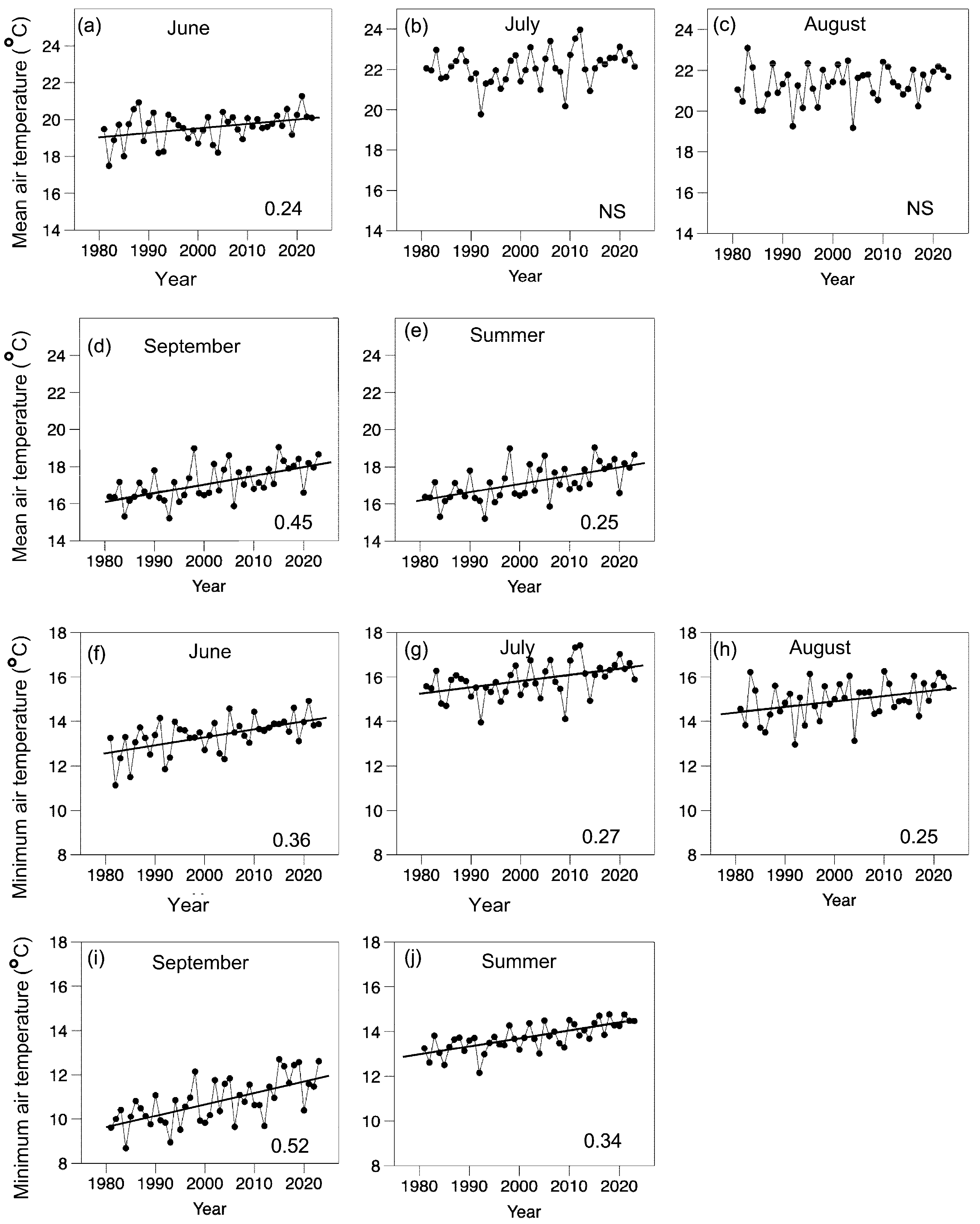

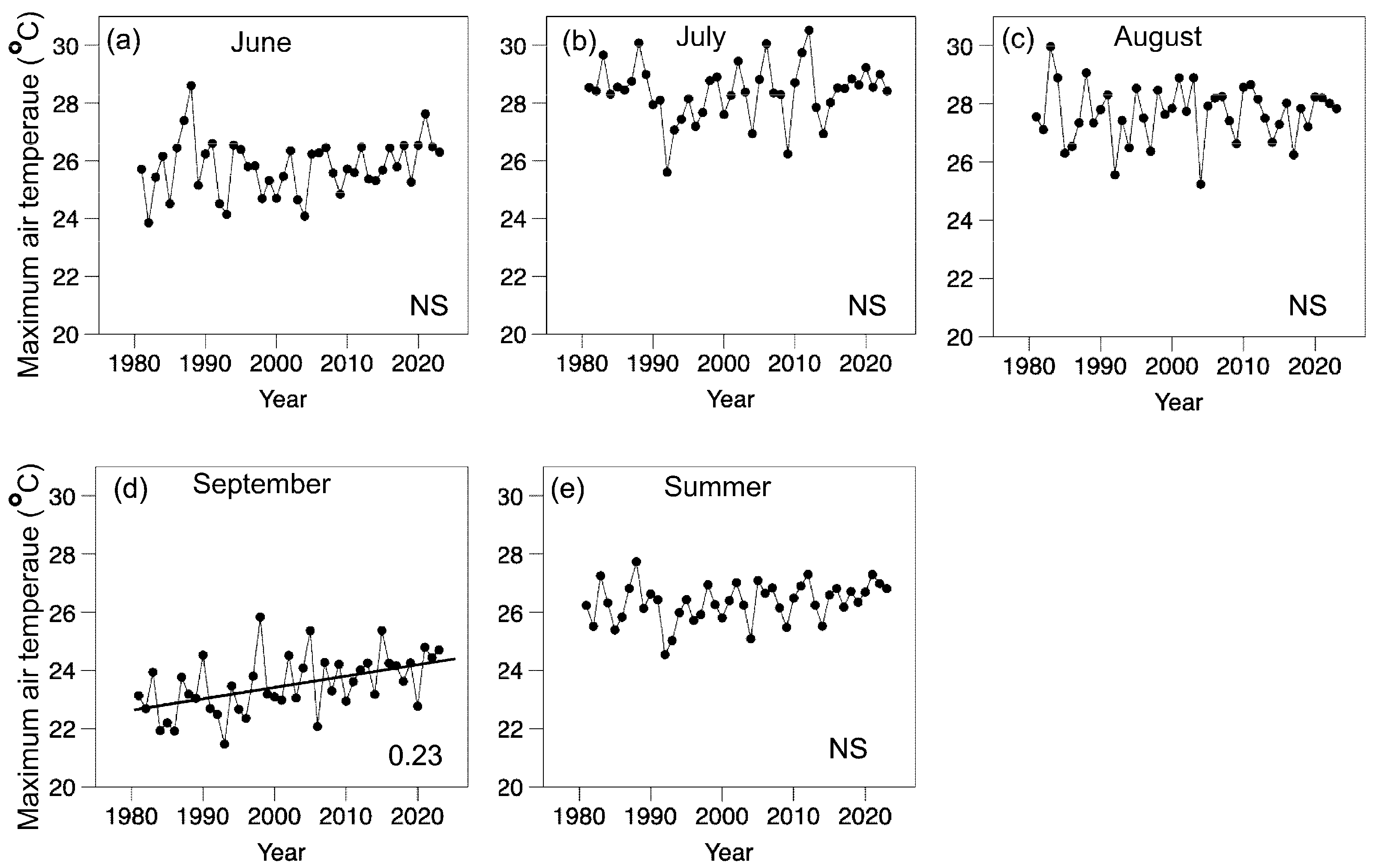
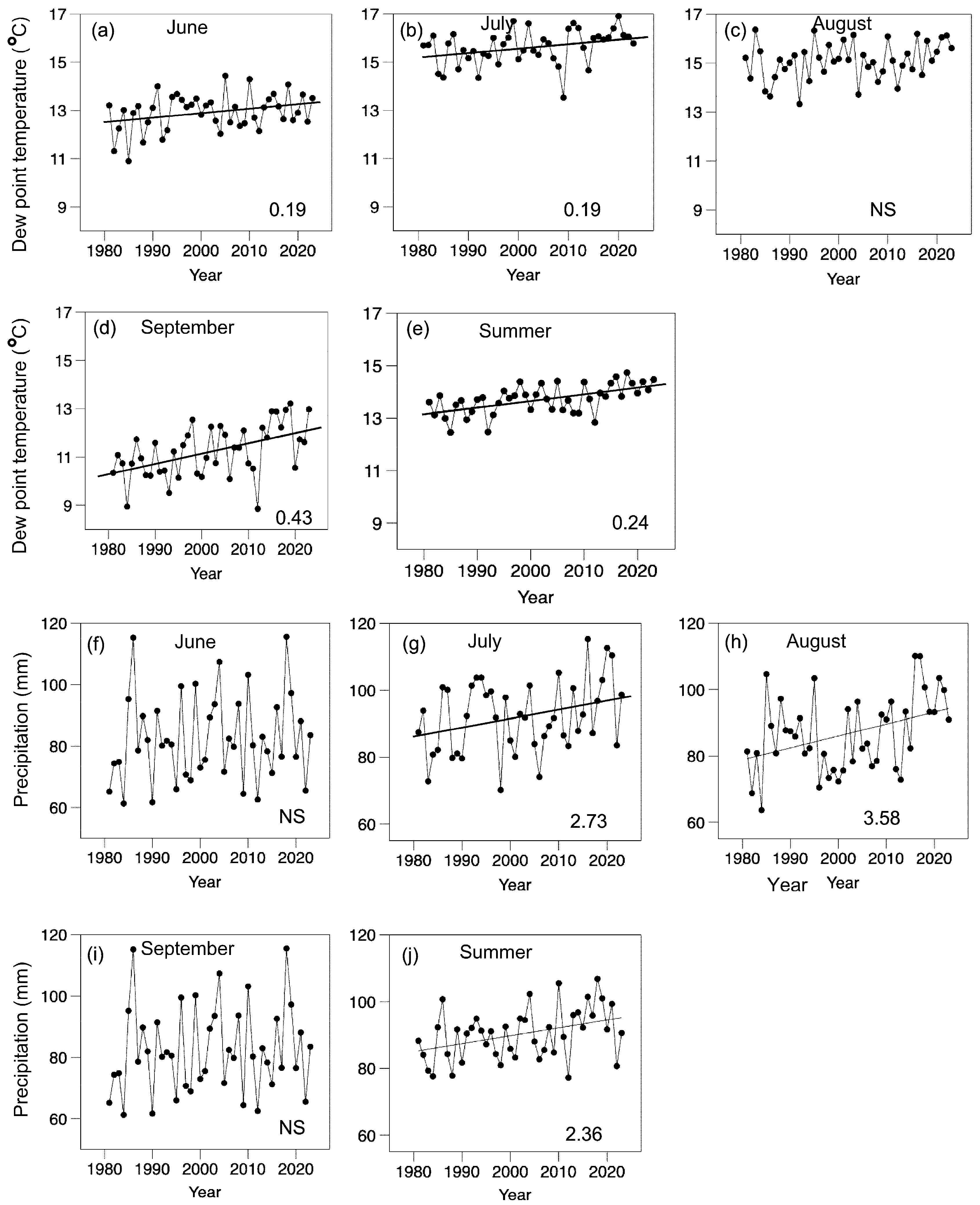
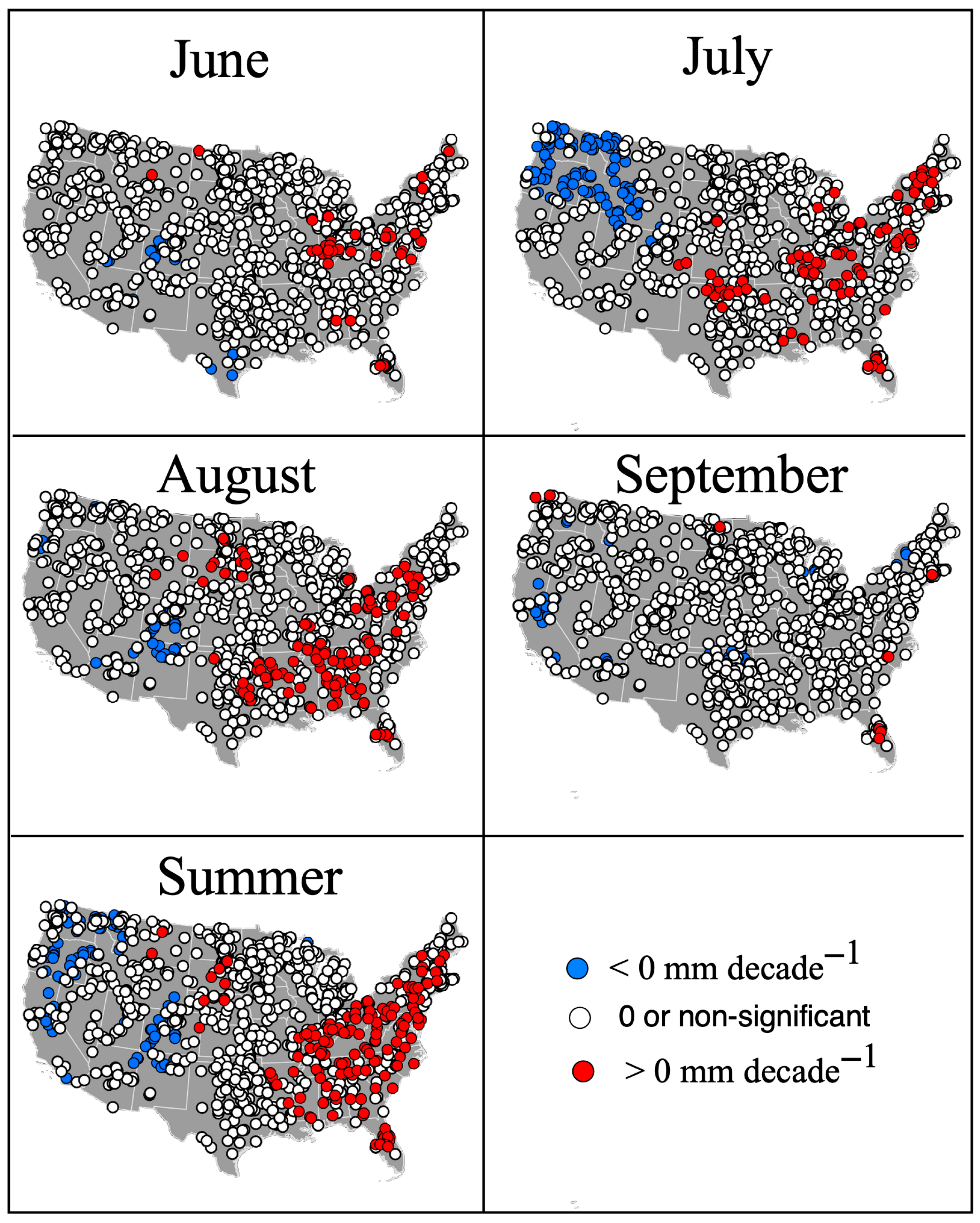
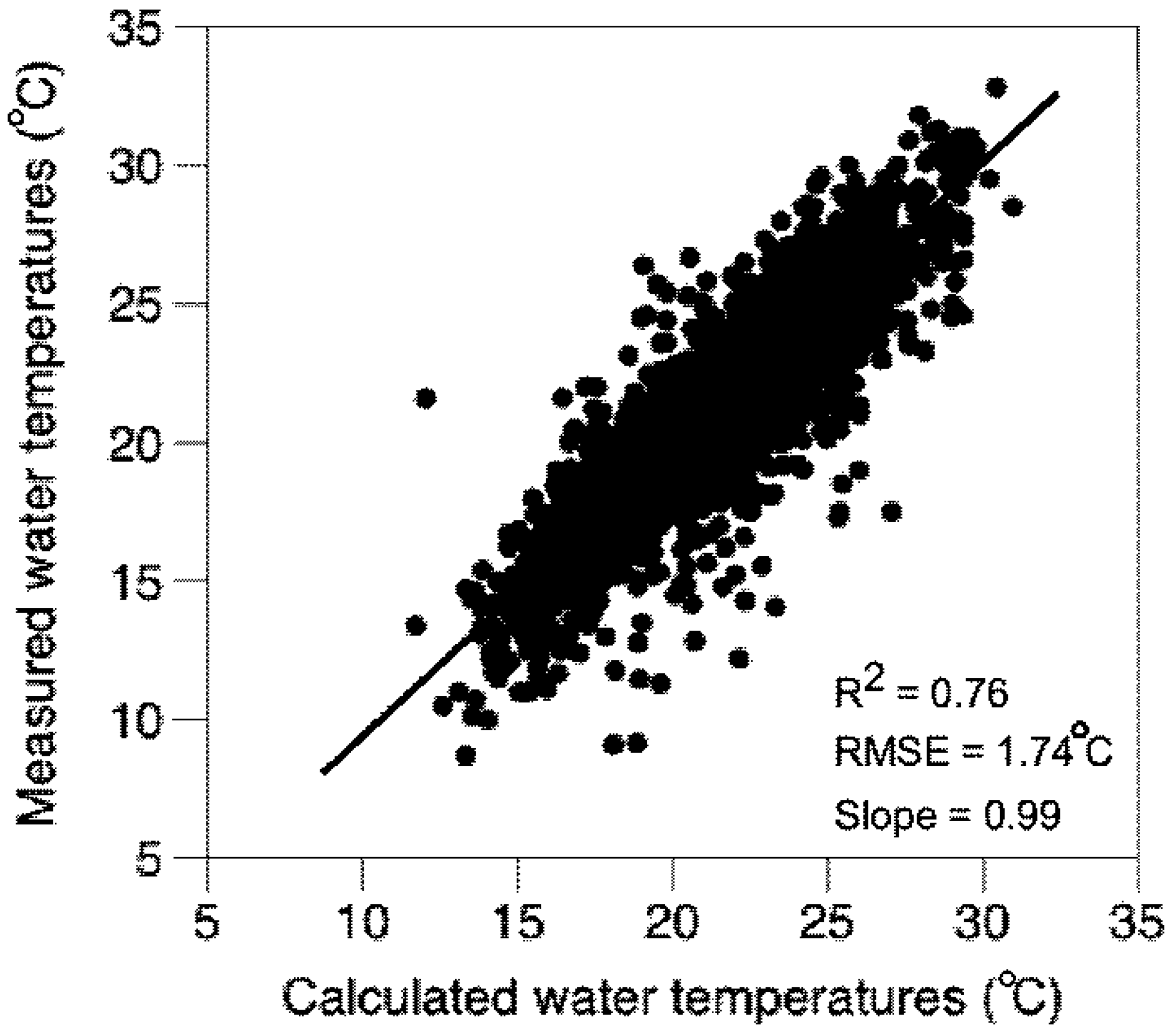
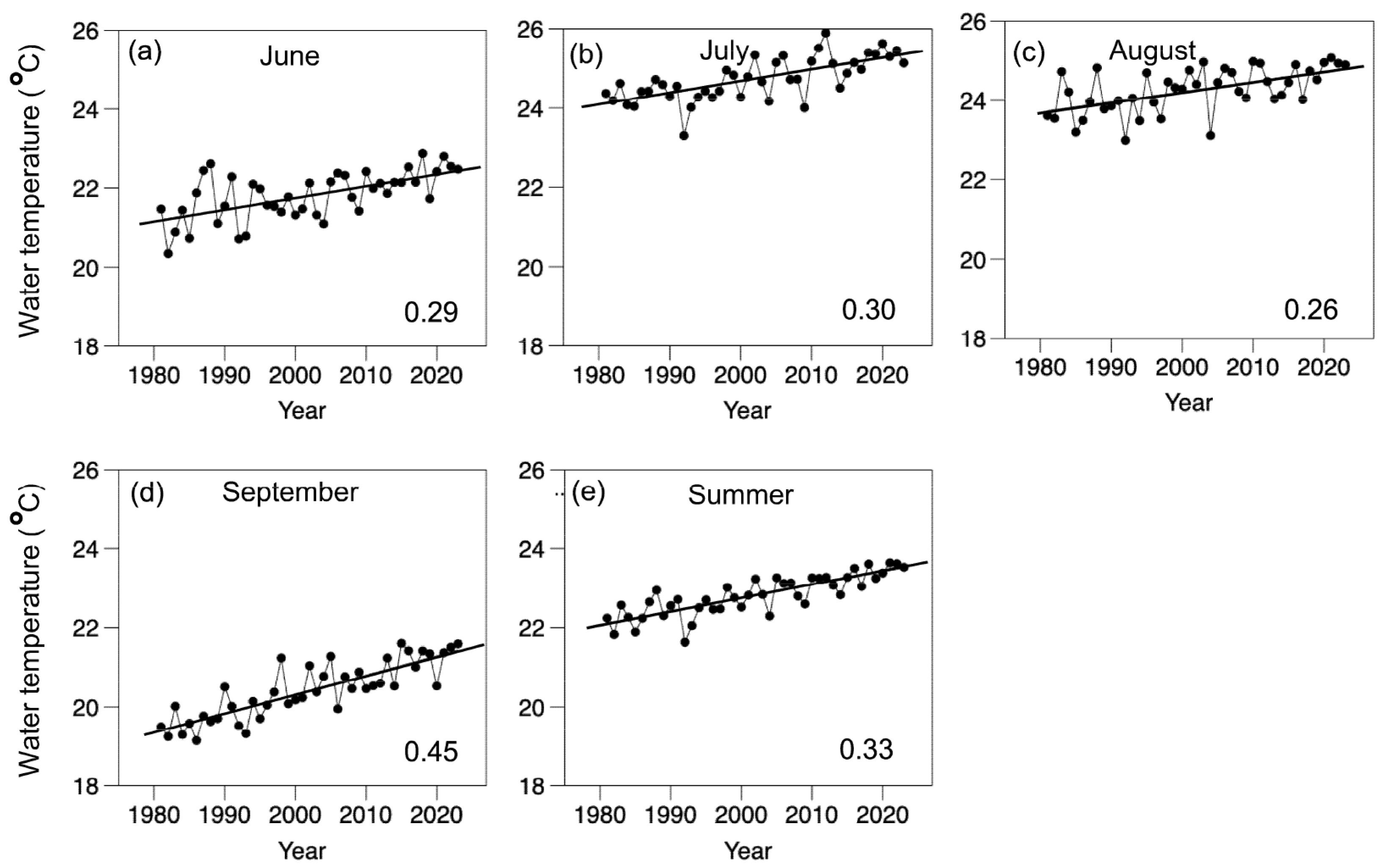
| Water | Mean Air | Min Air | Max Air | Precip | Dew Pt | |
|---|---|---|---|---|---|---|
| Mean | 0.25 | 0.22 | 0.34 | 0.12 | 1.08 | 0.18 |
| Standard Deviation | 0.07 | 0.18 | 0.21 | 0.19 | 3.85 | 0.21 |
| Standard Error | 0.002 | 0.006 | 0.007 | 0.006 | 0.120 | 0.006 |
| Frequency Distributions | ||||||
| Minimum | 0.00 | 0.00 | −0.29 | −0.31 | −9.05 | −0.61 |
| 2.5% | 0.14 | 0.00 | 0.02 | 0.00 | −4.80 | 0.35 |
| 25% | 0.21 | 0.00 | 0.23 | 0.00 | 0.00 | 0.00 |
| 50% | 0.24 | 0.25 | 0.34 | 0.00 | 0.00 | 0.22 |
| 75% | 0.29 | 0.35 | 0.48 | 0.29 | 0.00 | 0.31 |
| 97.5% | 0.41 | 0.59 | 0.76 | 0.54 | 11.68 | 0.58 |
| Maximum | 0.62 | 0.91 | 1.32 | 0.68 | 21.33 | 0.74 |
| Time Period | Rate of Change in Temperature (°C Decade−1) | Standard Error of The Mean (°C) |
|---|---|---|
| June | 0.29 | 0.06 |
| July | 0.30 | 0.05 |
| August | 0.26 | 0.06 |
| September | 0.49 | 0.05 |
| June–September | 0.33 | 0.04 |
| June–August | 0.28 | 0.04 |
| July–September | 0.35 | 0.04 |
| July–August | 0.28 | 0.05 |
| August–September | 0.37 | 0.04 |
Disclaimer/Publisher’s Note: The statements, opinions and data contained in all publications are solely those of the individual author(s) and contributor(s) and not of MDPI and/or the editor(s). MDPI and/or the editor(s) disclaim responsibility for any injury to people or property resulting from any ideas, methods, instructions or products referred to in the content. |
© 2025 by the author. Licensee MDPI, Basel, Switzerland. This article is an open access article distributed under the terms and conditions of the Creative Commons Attribution (CC BY) license (https://creativecommons.org/licenses/by/4.0/).
Share and Cite
Bachmann, R.W. Climate Change for Lakes in the Coterminous United States in Relation to Lake Warming from 1981 to 2023. Water 2025, 17, 2138. https://doi.org/10.3390/w17142138
Bachmann RW. Climate Change for Lakes in the Coterminous United States in Relation to Lake Warming from 1981 to 2023. Water. 2025; 17(14):2138. https://doi.org/10.3390/w17142138
Chicago/Turabian StyleBachmann, Roger W. 2025. "Climate Change for Lakes in the Coterminous United States in Relation to Lake Warming from 1981 to 2023" Water 17, no. 14: 2138. https://doi.org/10.3390/w17142138
APA StyleBachmann, R. W. (2025). Climate Change for Lakes in the Coterminous United States in Relation to Lake Warming from 1981 to 2023. Water, 17(14), 2138. https://doi.org/10.3390/w17142138





